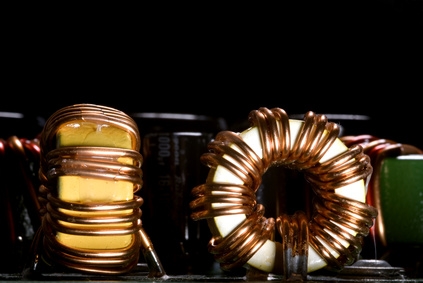
Automobile ignition systems do one thing: deliver a spark of several thousand volts to the spark plugs at exactly the right time from a six- or 12-volt battery. The distributor gets the spark to the right place at the right time in what is called the secondary circuit. The primary circuit initially created the large spark, and at the heart of the primary circuit is the ignition coil.
In electronics, when you put current through a coil, it creates a magnetic field. When the current stops, the collapsing magnetic field creates a current in the wire. How a coil behaves with a rapidly fluctuating current is more interesting: It can choke off some frequencies, or it can alter the fluctuating current in other ways. An ignition coil is not a coil in the electronics sense (because it has three terminals). It is actually two coils connected together with the common connection being the third terminal. The behavior of the two coils can be explained in terms of rising and falling magnetic fields.
The two coils inside an ignition coil are different sizes--one of them has 10,000 times as many windings as the other. Two coils in close proximity (without a common connection) make up a basic electronic component called a transformer. Alternating current, through the small coil, will produce a magnetic field that is constantly growing and collapsing in the windings of both coils. The changing magnetic field in the second coil produces a new current. The size of the new alternating current is changed (transformed)--the new size depends on the ratios of the windings of the two coils in the transformers. This voltage amplification ability is a key function of the ignition coil that makes the ignition system work.
Coils convert some of the electricity flowing through them into a magnetic field which is later converted back to electricity. Condensers (or capacitors in automotive terms) can also store up an electric charge and release it later. If you connect a coil and a condenser in a series--and if they are both the right size--they can start to "oscillate." The collapse of the magnetic field in the coil becomes synchronized with the pile up of electrons on the plates of the condenser. Once the oscillation starts, the electricity has to be turned off to stop the oscillation.
When the ignition coils start oscillating with the condenser, the magnetic field in the ignition coil starts getting stronger and stronger. At exactly the right time, a mechanical switch, called the "points," breaks the oscillator circuit. Then the strong magnetic field collapses, which induces a sudden spike of current out of the ignition coil.